During dinner, a tremendous procession of cars and lorries with flag-waving, cheering crowds announced that Luganville had won a local football Derby. You would have thought a revolution was about to begin.
Earlier, while paying our customs dues after going to the bank, we had met an Englishman who runs one of the local diving companies, who gave us a lift back into town, by the end of which it was agreed that Helen would go for her first, introductory dive, over the wreck of the US liner, the President Coolidge. This was sunk when, acting as a troopship during the second war, when Santo was a huge US forward military base for the Pacific, it ran into one of their own mines. Luckily, of more than 5000 men on board, only one life was lost, as she was close to the fringing reef, itself close inshore, and was quickly beached. But she didn’t get quite far enough onto the reef and she later fell back into deep water and sank.
The dive was a great experience: the water was slightly cloudy but it was extraordinary to see the ship, still largely in tact, lying on its side beneath us (not possible to go inside it on one’s first dive), and then to see, not only the many tiny and brightly coloured fish, but an enormous grouper (pronounced “groper”), known as Boris, who must have been more than 6 feet long and certainly that round.
The following day, we left for our small island. We threaded our way between the many islands in the approaches to Santo, through tide rips and eddies – the first encountered since we left home! Then a short but rough crossing, on the wind, of the historic Bougainville Strait. There had been a belief since the ancient Greeks that there must be a huge landmass in the southern hemisphere, and in the 16th century explorers of all nationalities were sent to discover it – Terra Australis Incognita – the Great Southern Continent – on the assumption that once found it would yield great riches. The island of Espiritu Santo was discovered by the Spanish in 1606, assumed to be the great southern continent and named “Australia del Espritu Santo”. It wasn’t until 1768 that the French explorer, Antoine de
Bougainville, sailed between Espiritu Santo and the island to its south,
Malekula, thus proving that Espiritu Santo was not after all Terra
Australis.
|
 |
We arrived off our chosen small island,
Vao, at about lunchtime, after a lively beat, and anchored in beautiful clear water slightly sheltered from the swell by a small sand spit, and well ventilated by the now quite strong trade wind.
|

 |
Canoes were drawn up on the white sand beach and a few were making their way across from the mainland about half a mile away. People waved as they paddled past and we waved back
. Mid afternoon, a small motorboat appeared from the mainland, laden with teenage children coming back from school and a few adults, who turned out to be teachers, and went back for a second load. They all waved and shouted greetings as they went past, and then climbed out of the boat straight onto the beach. We decided that this might be a good moment to go ashore, and rowed into the beach ourselves, where we were surrounded by small children, all completely used to boats, if not
inflatables, and helping us to carry the dinghy up above the reach of the tide and all saying “Bon jour” and “Comment t’appelle
toi?” with great excitement. Finally we made our way up the beach and were greeted by a man who had been sitting in the shade of a tree. We chatted to him (after a fashion, in French) telling him where we had come from and explaining that we had thought we would like to have a walk round the island and he started to walk with us, up towards the Catholic mission, complete with large church and infant school, and houses for priests and teachers – quite a complex. He was explaining what everything was, until we met another man, introduced as Monsieur Pierre, to whom we were handed over, and he continued to walk us on past the school.
|
It transpired that the islanders felt they had outgrown their space on the island, and most of them now commute the half mile across the strait to the mainland to work in their plantations (copra and coffee). They make much of this journey,
and everyone we spoke to explained how little space there is on the island
(l’ilot) and how they have to cross every morning to work in their “jardins” and come back every evening. The children and some of the teachers also commute – infants from the mainland to the island and senior children in reverse. Most children commute by motorboat, as we saw on our first afternoon, but we did see a few canoeing themselves across, presumably having missed the school boat – just two or three together, with no adult, coming to the primary school.
|
 |
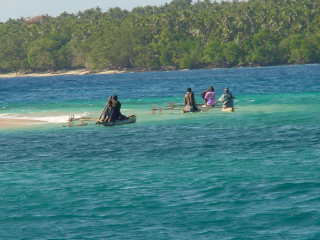
|
Monsieur Pierre walked us through woodland with many fruit and nut trees, apparently growing wild, and foraging pigs and chickens, past a very few houses, which were set in large swept bare earth compounds, and were again totally enclosed – with woven split bamboo sides and palm roofs, though some had louvred glass windows! The lack of space that everyone refers to was not at all apparent to us! The island had suffered two cyclones earlier this year and we wondered how the glass survived, but though there were still many trees down, any damage to the houses had been repaired. We came to a wide clearing in the wood, shaded by two magnificent large trees and swept clean of leaf litter, with some tall partially painted slit drums, known as tam-tams, to one side. Monsieur Pierre explained that this was the place for one village’s traditional gatherings, known as a
natsaro. (There are apparently 6 villages on this small island of less than 1 square mile, each with its own
natsaro.) The drums are made and placed in the natsaro by men at their “fete de mort” – a festival which each holds (and attends) before he dies. We later met someone whose father had already held his fete de mort, but whose grandfather, though elderly and rather frail, was still very much alive, so clearly fetes de mort are held in good time, just in case! Monsieur Pierre said that custom prohibits the taking of photos, but that we could seek the permission of the chief, though this was said in a way that seemed to discourage our asking – we didn’t have the camera with us anyway! There were large stone seats surrounding the drums and he also explained that these were where the men and boys would sit at a ceremony, while the women and girls would sit opposite, under the trees.
We walked on, past the circumcision house, where the young men live for a month around the time of their circumcision (our French really failed us at this point, I am afraid) and so back to the beach.
There is no electricity on Vao, and no telephone. There are no roads or vehicles, just beaten earth footpaths often partially blocked by fallen trees, or with very deep holes in them, or snaking gulleys from draining rainwater. Water is from a system of wells, and is also caught on roofs and stored in cisterns. Some wells have good drinking water, but others are brackish and only good for washing. We met many people carrying buckets back to their houses, including one very small boy, who we watched as he expertly lowered his bucket 25 feet or so, using a bamboo cane about 10 times his height, and hauled it back out, teetering all the while on his bare feet on the brink of the sheer-sided well. He staggered off, barely able to carry the full bucket.
The next day, we decided to try to visit the chief, to ask for permission to take photos. We went ashore and asked a girl to take us to the chief. She led us inland a bit, through the same natsaro as yesterday, then told us that we weren’t allowed to go any further and that the chief would require us to pay a fee to take photos and that he wasn’t on the island at the moment anyway! She took us back to the beach, and we decided to sit there for a while in the shade, waiting for people to arrive back from the mainland. We proved a major attraction for the children playing on the beach who came to stand round us in a wide semi-circle – a safe distance away from us – and stare! They were too young to speak much French so conversation was very limited! After a while, some men appeared and came, shooed the children away (with sticks!), sat down nearby and we got into general conversation with them – about the island, the system of government, the split between French and English speaking areas. One, Walter, spoke fluent English, which helped a lot(!), and we were able to ask him about the chief. It turns out that each village has at least one chief and that permission should be asked of each one, and that in any case, photography in the natsaros is
tabu. We then asked if it is true, as we had read, that there are many wood carvers on the island (not mentioned at all by Monsieur Pierre). Walter said that there are and that he could if we liked see if he could arrange to take us to see some the following morning. We said that would be wonderful, and he very diffidently asked if we were interested in buying or just looking. We said that we would find it interesting to see the process of carving, but that it was just possible that we might also buy something, which seemed to be fine.
The following morning, we met Walter on the beach, finally bringing the camera, tucked into a bag, in the hope that we might at least be able to take photos of the carvings. He told us he was going to take us to visit his grandfather and his uncle – his grandfather now being too old to carve, but his uncle having taken over. We might also then also go to see someone he described as his honorary father, who is the only full-time professional carver on
Vao. Having walked a few paces, having made sure there was nobody around, he produced from a small bag the skull of a pig complete with curled tusks, which he offered to sell to us. Pigs with curled tusks are greatly prized and considerable effort is put into growing pigs with them. We politely declined, not knowing which wall to hang it on in the cottage! He also offered us a conch shell, which we did buy. We walked with him through the same spectacular
natsaro, where he explained that one of the tam-tams was his father’s. He stopped to play it, and as he did so, he looked around cautiously and then asked if we would like to take a photo! He said it wasn’t allowed but if we were quick and no-one saw, that would be fine! We could hardly refuse what was clearly a generous offer. (Vanuatu004). We didn’t dare try to take a photo of the entire
natsaro, which was what we really wanted to do, as it would have meant walking back to the edge of it, and Walter, though clearly keen for us to take a photo, was also nervous.
We walked on and found that we were going on past the place where the girl had said we must stop. Gradually, it emerged that Walter’s grandfather is the chief of one of the other villages – we didn’t ask if he is the one who requires payment! |
|
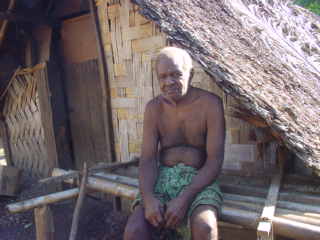
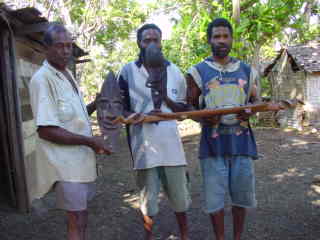
|
When we arrived at the grandfather’s we were introduced and asked to sit outside, while the uncle was summoned. There were a number of small, enclosed houses in the compound and a new one under construction – for another uncle about to return home from another island. The uncle appeared, asked if we would like to see some of his work, and, unlocking the door of one of the houses (the lock surprised us), produced a large bag full of carved wooden masks, and a long narrow platter. The masks are not intended to be worn, but are the traditional form of sculpture of the human face, and were varied and beautiful … and surprisingly expensive! The masks show a wide variety of faces and emotions and we immediately decided to buy one – the only problem being how to choose. One mask (held by Walter in the centre of the photo) was not for sale at any price – you may just be able to see the hooked nose with carved out nostrils, and the protruding forehead, which has been fully carved out from behind, not just left flat. The dish, which must be some 3 feet long had been carved out of a single piece of wood. We asked if we might see some work in progress, assuming that we would be taken to a workshop, but instead he brought his adzes and chisels to us. Much of the work, even quite fine detailing, is done using the adze with astonishing finesse, but speed.
|
|

|
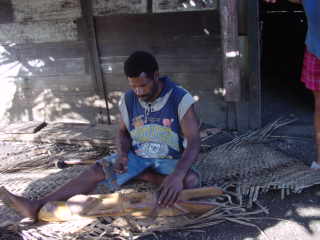
|
Finally, we left with our purchases and, immediately outside the compound, Walter steered us down a narrow path beside a clearing, which turned out to be another
natsaro. He explained that custom rules that women are not allowed into this particular natsaro at all, so we all took the side path. It transpired that this is one of the reasons why we had been accompanied every time we came ashore – to make sure that we didn’t stray into tabu places. Such places include the areas where pigs are killed in a ritual slaughter very important in the Vanuatu culture.
|
|
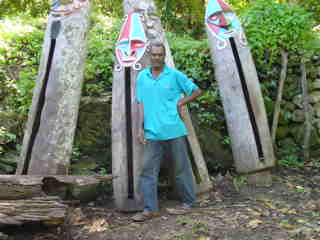
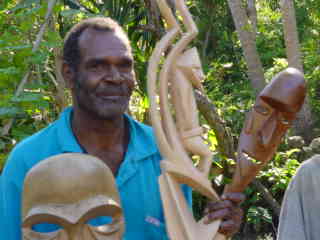
|
We went on to visit Walter’s honorary father (which concept we never managed to understand), who we found in a small workshop on the far side of his compound, surrounded by a jumble of wood and partly carved items, though of course the tools are all totally portable. He too showed us a selection of masks, and a traditional carving for the prow of a canoe (in the centre of the photo (Vanuatu009). He came with us to show us his tam-tams in the natsaro of his village, and again we were invited to take a photo (Vanuatu010). Monsieur Baudouin also showed us a series of statues he had carved and painted to order for a museum in Paris, which were due to be collected very shortly. They were housed in a tabu area which Helen was not allowed into, though she was allowed to look over the wall, and photos were clearly out of the question here. We hope to be able to find them in Paris one day! John thinks there is a possibility that the tabu system might be introduced into Odiham on our return!
|
As we started to leave, we found ourselves asking ... how long would it take to make a tam-tam, … how much would one cost? and then we had commissioned one to stand about waist high – as large as we thought we could fit in the boat. We were told that work would start immediately and that we could visit to see progress day by day over the three or so days it should take. We were taken back to the natsaro to choose the style of face we preferred.
The following morning, at 0600, whilst it was still dark, with directions from Walter, we motored across to the mainland in the dinghy, realising as we did just what a tough commute it could be by canoe, with strong cross currents and potentially quite a big swell and a choppy sea as well. We were aiming for the first mini-bus down to the main towns of Malekula (towns because one was the former centre for the French administration and one for the British!) We were interested to note that in the bus driver’s family compound a new house was under construction from breeze blocks, rather than bamboo. We set off first in the wrong direction back through the village on the mainland to collect other passengers, and as we drove, one or two people stopped the bus and clearly commissioned the bus driver to carry out some errand or other in town – a sort of post bus. Finally we set off down a rough track with plenty of potholes, which had to cross several rivers, going steeply down into a dip to cross a bridge that was clearly being undermined and eroded by the flow, making the bridges only just wide enough for the bus to get across. It must be a dreadful journey in the wet season – all but impassable. A fellow passenger explained that the village (which is at the far end of the track) repeatedly asked the local authority to improve the road, but they never did.
Although we passed through a number of other villages on the way, we didn’t pick anyone else up – this bus clearly served its own village only. One of the villages we passed was holding a small vegetable market by the side of the road, but the bus sadly didn’t pause.
We were able to see the copra in production – after they fall, the coconuts are split, and husked, then piled to dry in kilns, with the slow-burning fires lit in huge metal tubes running through corrugated iron sheds. The copra, once dried, is bagged up and taken away by sea, loaded onto a small cargo boat which doesn’t anchor, but motors round in small circles while the bags are loaded from the beach onto a small lighter and trans-shipped onto the boat. We were told that copra is a hard crop, requiring a lot of work and skill. Everyone much prefers growing cocoa “which even a child could grow”.
Later (the journey took just over an hour to cover about 20 miles – poor roads but no traffic!) we came to a huge coconut plantation, the largest in Vanuatu, with an industrial processing area and many small houses crammed together for the plantation workers. It seemed most out of place. The plantations themselves were spacious, with regularly planted coconut palms interspersed sometimes with coffee bushes, but more often with grass cropped low by cattle. We saw only one man in the plantations, which must have stretched for 5 miles or so, riding through the trees on his horse.
The road only became a finished surface a few miles before
Norsup, the French town, and electricity poles appeared here too. Norsup contained the hospital, where we delivered an elderly woman to the door, and a large school. The English town,
Lakatoro, was very spread out, with a large memorial sports field in the centre, and a few shops, a bank and a clinic scattered loosely around it. The bus driver collected us about an hour and a half later from the spot where he had dropped us, as well as the lady from the hospital and a few other returning passengers, complete with large sacks of rice and huge bags of vegetables. We had found a cluster of tiny crabs tied together, which came back with us to make a change for supper. On the way back, going up a steep hill in the middle of nowhere, the bus stalled and passengers started to get out. We thought we would have to push the bus. But the driver, having put stones under the back wheels to stop us rolling back down hill, tinkered for a while with something under one of the passenger seats and the engine stuttered and finally re-started – to our great relief! As we passed the village market, we paused momentarily while bags of produce appeared and were handed in, and then back in the village, the driver handed out a number of packages, discharging his various commissions.
|
|
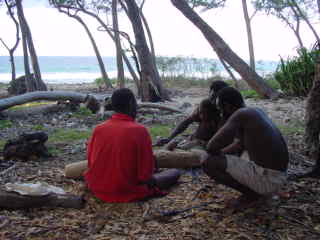
|
That afternoon and the following one, we went with Walter to see progress on the tam-tam. Many people we passed seem to know about the tam-tam and reported on its progress. Interestingly, it was not being carved in M Baudouin’s workshop, but out in the nearby wood. It turns out that custom requires that women do not see a tam-tam (that is, one made for custom purposes) so it is always made “in the bush” where the tree or branch was cut. Then it has to be hidden, such as in one of the men-only kava drinking huts, so that it is not seen by women until its public inauguration. Because ours was not being made for custom purposes, it was alright for Helen to see it while it was being carved, but it was nonetheless being made some distance from M Baudouin’s workshop, under the trees by the sea on the upwind side of the island – a lovely spot on the edge of a coconut plantation with the wind blowing freshly and quite large waves pounding the fringing reef.
|
During these walks across the island, we were the subject of much interest from the villagers. Walter was rather embarrassed by the way the children reacted – playing “touch the white man” when our backs were turned and then running away. Only the boldest would come forward to shake hands, though sometimes curiosity would get the better of them and gradually an entire group of children would dare to approach us. Walter would mutter that “they are like bushmen, as if they have never seen a white man before”. It seems that yachts do stop here fairly frequently, but visitors are clearly still relatively rare. Many of the women giggle a bit when wished “bon jour” and seem embarrassed. But others are very keen to say hello and determined to shake hands. The men of the island seem much more conspicuously involved with the children than we have seen elsewhere – we often met men cradling a small baby or carrying a toddler. Out of school, the children used the beaten footpaths to play marbles, and some game which required the scoring of squares into the mud, though when John tried out hopscotch on one, they looked on in amazement. In one
natsaro, we came across some boys competing to throw home-made arrows high up into a tree – a sharpened stick, smoothed by removing all the bark and with the other end split into quarters to make the flight.
One evening, we heard a party in progress near the beach, with a band playing and singing. It was tempting to go ashore to investigate, and to be able to hear better, but “custom” seems to place rather a barrier between visitors and locals, and we didn’t want to embarrass anyone.
Many people of all ages, on their way to or from the mainland, stopped to say hello or to have a chat, some to offer a gift of a vegetable, or to sell something. Everyone waved as they went past, even if they didn’t stop. We discovered that the young boys make their first canoe at the age of about 12 or 13. The girls do not make their own canoes, but the girls and the women are just as adept at handling them as the men and boys.
|
|
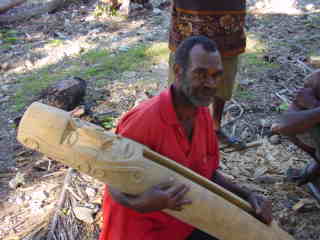
|
Finally we went to collect the finished tam-tam, (Vanuatu015) and went back through the natsaro to take down the details of the custom colours so that we can paint it ourselves. We had such a following by this time, that taking a close-up photo was out of the question, so we painstakingly drew out the placing of the colours, which is quite complicated, given that only red, white and blue are used. Monsieur Pierre was our guide again this time, and he very kindly carried the extremely heavy tam-tam for about half an hour back to the beach!
|
On our last morning, we went to church before we left to sail back to Santo. We had asked what time the service was and were told at about 8, or 8.30, or 9! People gathered outside the church from about 8, very much in Sunday best clothes, with new dresses trimmed with lace and ribbons for the women and girls. Then the two tam-tams outside the church, which serve as bells, were beaten and everyone went in, though people continued to arrive long after the service had begun. Women sat to the left of the aisle and men to the right, though many of the men were looking after small daughters as well as sons. Walter had told us that each week a village takes it in turn to lead the singing and the readings and intercessions, every village trying to do its best “so that it is like a competition”. The priest spoke in Bislama (coming from Tonga, he doesn’t speak French), but the lessons and intercessions from the villagers were in French. The priest welcomed us to the church, which was only apparent to us when everyone present turned round to look at us! The difficulties in language had been illustrated to us by Walter, whose wife comes from Malekula (the “mainland”) and speaks a different dialect to that used on
Vao. They speak to their daughter in Bislama, but all the other Vao children learn dialect first, so she can’t talk to them properly till they all go to school, where they are taught in
Bislama.
We made our farewells and had a rather faster sail back before the wind to Santo, though we picked up a mooring off a small hotel on
Aore, a small island opposite Santo, where it was much more sheltered from the wind. The hotel is run by a nice Australian couple, who make yachtsmen welcome, with fresh water, an excellent restaurant, laundry and a ferry service across to Santo.
|
|
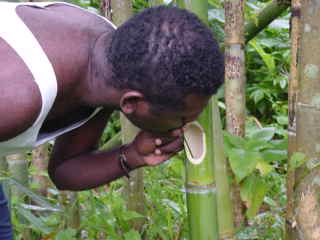
|
They organised a visit to a traditional village one day. It was said to be a new venture by a village to show aspects of their traditional way of life and it was certainly new enough that our driver spent a lot of time asking the way, as we neared the village! We had driven for about three quarters of an hour on unmade track when he stopped and we got out to walk for about half an hour through the “jungle. On the way, the driver showed us how locals could always satisfy their thirst anywhere where bamboo grows, by first cutting a small shoot to act as a straw, and then a hole in the main stem to drink from
(drinking_bamboo, sent by email). He also pointed out which coconut trees are safe to walk under on a windy day, and which not – once the coconut shells go brown, they are ready to fall of their own accord.
|
|
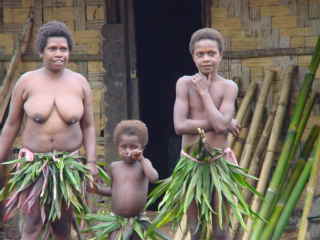
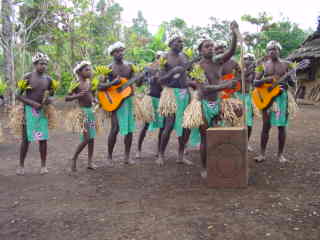
|
When we arrived, the villagers had dressed in “traditional” dress. The men’s all looked rather clean and new, and the women’s extremely uncomfortable - hard and scratchy round the middle! They welcomed us with a string band performance: normal guitars, a locally made
ukelele, a couple of small bamboo slit drums, and, at the front of the picture, a wonderful bass instrument – with its single string attached to a square box at one end and to the top of a pole at the other. Different notes were played by moving the pole backwards and forwards to change the length of the string – and it was very effective. There was also a short display of dancing in the open space in front of the chief’s family’s long house. Everyone, including the chief, wanted his or her photo taken
and they were delighted to see their pictures on our digital camera. They had seen video before, but were still intrigued by the instant pictures.
|
|
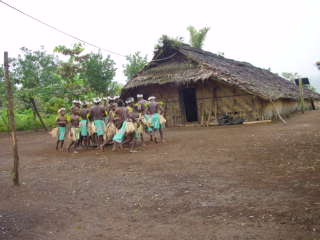
|
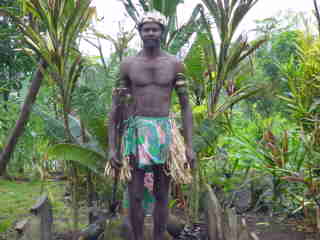
|
|
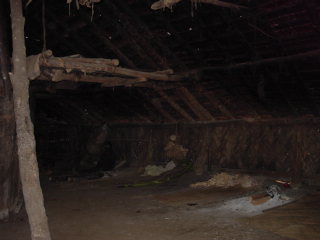
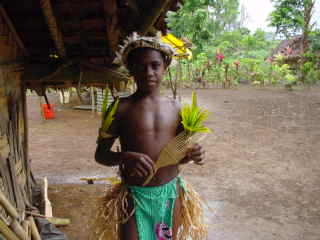
|
They invited us to take photos of the inside of the long house, in which everyone in the family sleeps on woven mats in a row down each side, dormitory-style. There were the remains of a large fire from last night’s dinner, and the chief’s elderly and frail mother (just visible at the front of the photo) sat on her mat, next to her own small fire to keep her warm. They showed us the huge wooden platters on which food is traditionally served, and various smaller wooden dishes carved by the younger members of the family. The chief’s youngest son, at 9 years old, was the most talented and he was proudly encouraged to show us a fine Afro-style comb he had carved.
|
We did notice a solar panel and one fluorescent bulb in the long house. But water has to be carried up a steep slope from the river below, (you can just see the edge of the slope in the photo (Vanuatu024), of what should have been a spectacular view, had it not started to pour with rain!). The family were keen to explain the traditional use of various plants for flavouring drinks, the ubiquitous kava, and so on.
It was an interesting outing, though hard to unravel what is still a normal part of daily life, and what being shown as traditional, for the benefit of visitors. For example, the neighbouring villagers were all (very sensibly) wearing shorts and T-shirts, but the long house was clearly home.
The next day we set off for Australia, hoping to escape the reputed pirates off Papua New Guinea and the accelerated trade winds and accompanying rough seas for which the Torres Strait is renowned. |